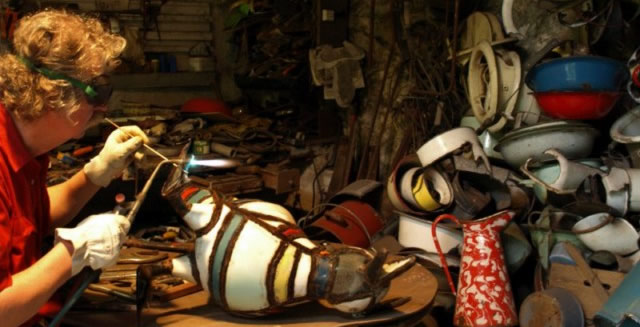Elaboration d'une sculpture
Sur le tableau de mon atelier, je décroche le croquis que j'ai choisi de réaliser. C'est un croquis élémentaire, une simple note prise pour fixer une idée jaillie. Elle pourrait être écrite. Je commence à dessiner ma forme en tordant du fer à béton, de face puis de profil. Je détermine l'encombrement de la sculpture dans l'espace. Je dresse toutes les verticales en fer à béton, je souligne les détails. La structure est essentielle, la tôle émaillée n'est que le recouvrement de l'espace délimité par elle. Comme en architecture, les murs rideaux ferment l'espace créé par l'ossature métallique. La structure terminée, j'y place symboliquement un cœur. La sculpture vit déjà. Et je commence à faire les pieds afin d'assurer dès l'abord la stabilité de la sculpture et je monte progressivement mes tôles. Quand l'essentiel du corps est terminé restent les bras et la tête dont les structures n'ont pas été faites. Je réalise d'abord celles des bras, auxquelles je soude les mains. Des mains, je rejoins les épaules. Je termine par la tête. Le travail de soudure est terminé.
Mes sculptures sont datées, signées, et numérotées d'un cordon de soudure sous les pieds, ou autre emplacement invisible à l'exposition.
Commencent toilette et retouches. Je nettoie la sculpture avec de l'Ajax et du Scotch Britt, comme une simple casserole. Je masque ensuite les quelques éclats d'émail inévitables avec la dilatation des tôles. J'utilise pour cela du mastic à voiture que je ponce après séchage. Je fais ensuite les retouches de couleur à ces endroits avec une peinture émaillée. La sculpture est terminée. J'aurai mis 3 à 9 mois pour la faire si c'est une grande pièce, 3 à 4 semaines si c'est une petite. En finition, je la passe au cirage incolore, et je la fais briller avec un chiffon de laine, comme on le fait pour les chaussures.
Ce qui était dans l'ombre est là, sous les projecteurs et c'est peut-être beau. Mélois
From the bulletin board in my studio I take down the sketch that I have decided to produce. This elementary sketch is just a note made to fix an idea when it emerged. Sometimes the note is in written form. Working with metal rods used to reinforce concrete, I begin designing my form, twisting the rods to trace out the front view and then the profile. I determine the mass of the sculpture which will occupy the space. Placing all the verticals with the iron rods, I underline the details. It is the structure which is essential; the enamelware is only the covering of the space traced out by the piece. As in architecture, the curtain walls enclose the space created by the metallic skeleton. When the structure is completed, I symbolically place a heart in it. The sculpture is already alive. To assure its stability from the very beginning, I start by making the feet. Next I work on the pelvis, progressively working my way with the metal plaques to reach back down to the feet. This is the first stage. Then I work up from the pelvis to the neck. Thus the body is essentially completed. This leaves the arms and the head, whose structures are not yet made. First I do the structures for the arms and solder the hands to them. From the hands I work back to the shoulders. I finish with the head. The work of soldering is done.Then I turn to the finishing and touching up. I clean the piece with Ajax and scotch-brite, like an ordinary pot. Then I mask over the inevitable chips in the enamel caused by the dilation of the metal plaques. For this purpose I use metal fill for automobile bodywork, which I let dry before polishing. Finally I touch up the color on these spots with enamel paint. The piece is completed. It takes me three to nine months to make the large pieces, three to four weeks for the small ones. For the finishing touch I wax the sculpture with colorless wax and polish it like a pair of shoes, with a wool cloth.
I like words, I like to play with them in my titles.
I like paradox. That shadow be sun, that garbage turn to pure gold. My satisfaction comes as much form the fact of doing what is said to be ((unusual)) sculpture as from the idea that what was once a chamber pot is put into a living room and contemplated with love. Of course the chamber pot was cut up and crunched, and if I didn't say anything maybe no one would know that it's a chamber pot. But I know it, and that pleases me, and I do say so and it pleases me to say so.
Something which has been hidden in the shadows is now out there under the spotlights. And maybe it's beautiful.
Mélois
(English adaptation by NIDRA POLLER)
